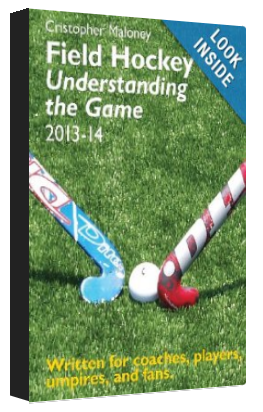 |
| Search |
|
|
UmpireHockey.com
is published by
Cris Maloney.

|
 |
Helpful Documents
Attached are the NCAA's official modifications to the Rules of Hockey governing play in NCAA games during the 2014 season.
In addition, changes that UmpireHockey.com would like to see made to the 2014 modifications are detailed below.
"4.3. TIMEOUTS d." AS CURRENTLY WRITTEN: Point of Emphasis: It is not permissible for anyone from the bench area to enter the field of play to call a timeout.
"4.3. TIMEOUTS d." RECOMMENDED CHANGE: Point of Emphasis: It is not permissible for anyone from the bench area to enter the field of play to call a timeout. Further, it is most desirable for a player in the game to indicate to the umpire of the team's request for a timeout.
RATIONALE: It is unsightly for spectators to watch a team's coach or other bench personnel yelling, sometimes screaming, at an umpire to signal a timeout. The team about to receive the timeout has possession of the ball and need not put it into play before asking the umpire for a timeout. The coach should communicate with the players. The players should communicate with the umpires.
"4.3. TIMEOUTS f." AS CURRENTLY WRITTEN: At the 1:45 minute mark of the timeout a warning signal will be made -- by the umpires -- and an umpire will notify each coach of the signal.
"4.3. TIMEOUTS f." RECOMMENDED CHANGE: At the 1:45 minute mark of the timeout a warning signal will be sounded by facility personnel (not the umpires). This sound will be the only notice the coaches will receive that play will resume in 15 seconds.
RATIONALE: Minimize time wasting. Clarification. Simplification. As currently written, the umpires are instructed to make an undefined signal (...clear throat? ...wave hands in the air? ...blow whistle?) at the 1:45 minute AND THEN tell each coach that they made the signal. Seriously? "I'm notifying you that I made the signal." This seems both over engineered (providing a notification that the signal was made) and lacks precision (the signal should be defined -- air horn? ...bell? ...whistle?). Next thing we know is that we'll be asking the umpires to get the coaches to sign a card confirming the receipt of the notification of the signal that was given back at the 1:45 minute mark. It is no wonder that upon measuring the length of timeouts in college games, one will find that play often isn't resumed until nearly 4 minutes has passed since the clock was stopped. Some timeouts exceed 5 minutes in length.
"4.3. TIMEOUTS g." AS CURRENTLY WRITTEN: A second signal will be made at the 2:00 minute mark and play must be resumed immediately.
"4.3. TIMEOUTS g." RECOMMENDED CHANGE: At the 2:00 minute mark, one of the umpires, as determined by the umpiring team, will blow his/her whistle to restart the game clock.
RATIONALE: Clarification and simplification. The signal given at the 2:00 minute mark should be the signal that restarts play, i.e. ends the timeout. As written, umpires make a signal (blow whistle?) at 2:00 to indicate the end of the time out and THEN go about getting the teams out of their meetings and into ready positions and THEN "immediately" resume play. All one has to do is time timeouts at college games to get an objective measure of just how flawed the timeout instructions are as currently written. We are wasting time that would otherwise be spent enjoying game action. NOTE: The situation is just as bad during high school games. Let us hope that both NCAA and NFHS games will move from halves to quarters in 2015 and that timeouts will, therefore, be eliminated.
"4.3. TIMEOUTS h." AS CURRENTLY WRITTEN: If a team delays in returning to the field, the captain will be carded for delay of game.
"4.3. TIMEOUTS h." RECOMMENDED CHANGE: If either team is not ready to resume play when the game clock is restarted by the umpire's whistle, the captain of that team/those teams will be carded for delay of game. This carding will not impact how play is resumed except that the carded captain(s) must serve the suspension as indicated by the card.
RATIONALE: Clarification and simplification. Makes it clear how to judge delay of game and how the carding of the captain will impact the delayed restart of the game.
"9. ADDITIONAL INFORMATION h." AS CURRENTLY WRITTEN: A goal will only be awarded when an attacker within the circle plays the ball legally. [FIH Rule 8.1 "Own Goal" will not be in use.]
"9. ADDITIONAL INFORMATION h." RECOMMENDED CHANGE: Delete h.
RATIONALE: This is not a modification. FIH Rule 8.1 does not permit the Own Goal. Perhaps, for one year, add a Point of Emphasis to these modifications that states simply, "The 'Own Goal' is not used in NCAA field hockey games." But, even that seems unnecessary.
"9. ADDITIONAL INFORMATION j." AS CURRENTLY WRITTEN: [snip] Any violation of this rule modification will result in a misconduct penalty of a yellow card and minimum 5 minute suspension.
"9. ADDITIONAL INFORMATION j." RECOMMENDED CHANGE: [snip] Any violation of this rule modification will result in a misconduct penalty BEGINNING with a yellow card and minimum 5 minute suspension.
RATIONALE: This modification, without the word "beginning" implies that an umpire may never do anything but give a 5-minute yellow card for this misconduct, even if it is repeated. +++++++++++++++++++++++++++++++++++++
ADVERTISEMENT: Thinking about coaching or umpiring? Want to be a better player?
Do you know a bewildered parent trying to figure out what's going on?
 $12.99 USD. Available on Amazon and FieldHockeyBook.com $12.99 USD. Available on Amazon and FieldHockeyBook.com
+++++++++++++++++++++++++++++++++++++
CLICK HERE FOR 2014 NCAA FIELD HOCKEY MODIFICATIONS
Copyright © 2002-
UmpireHockey.com
Top of Page
|
|
 |
Helpful Documents
Latest Headlines
|

|